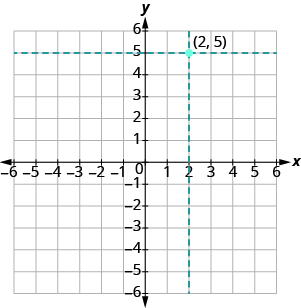Learning Outcomes
- Plot points on a rectangular coordinate system
Rectangular Coordinate System
The coordinate plane has similar elements to the grid shown above. Look at the Rectangular Coordinate System shown in the box below. It consists of a horizontal axis and a vertical axis: number lines that intersect at right angles. (They are perpendicular to each other).
The horizontal axis in the coordinate plane is called the [latex]x-axis[/latex]. The vertical axis is called the [latex]y-axis[/latex]. The point at which the two axes intersect is called the origin. The origin is at [latex]0[/latex] on the [latex]x-axis[/latex] and [latex]0[/latex] on the [latex]y-axis[/latex].
The intersecting x- and y-axes of the coordinate plane divide it into four sections. These four sections are called quadrants. Quadrants are named using the Roman numerals I, II, III, and IV beginning with the top right quadrant and moving counterclockwise.
The rectangular coordinate system

Locations on the coordinate plane are described as ordered pairs. An ordered pair tells you the location of a point by relating the point’s location along the x-axis (the first value of the ordered pair) and along the [latex]y-axis[/latex] (the second value of the ordered pair).
In an ordered pair, such as [latex](x, y)[/latex], the first value is called the x-coordinate and the second value is the y-coordinate. Note that the x-coordinate is listed before the y-coordinate. Since the origin has an x-coordinate of [latex]0[/latex] and a y-coordinate of [latex]0[/latex], its ordered pair is written [latex](0, 0)[/latex].
Ordered Pair
An ordered pair, [latex]\left(x,y\right)[/latex] gives the coordinates of a point in a rectangular coordinate system.
[latex]\begin{array}{c}\text{The first number is the }x\text{-coordinate}.\hfill \\ \text{The second number is the }y\text{-coordinate}.\hfill \end{array}[/latex]

Plotting Points in the Coordinate Plane
Now that you know the components of a rectangular system, let’s learn how to plot ordered pairs, that is locate a point on the coordinate system given an ordered pair. Just remember, the process starts at the origin—the beginning!
Let’s try locating the point [latex]\left(2,5\right)[/latex]. In this ordered pair, the [latex]x[/latex]-coordinate is [latex]2[/latex] and the [latex]y[/latex]-coordinate is [latex]5[/latex] .
We start by locating the [latex]x[/latex] value, [latex]2[/latex], on the [latex]x\text{-axis.}[/latex] Then we lightly sketch a vertical line through [latex]x=2[/latex], as shown in the image below.

Now we locate the [latex]y[/latex] value, [latex]5[/latex], on the [latex]y[/latex] -axis and sketch a horizontal line through [latex]y=5[/latex] . The point where these two lines meet is the point with coordinates [latex]\left(2,5\right)[/latex]. We plot the point there, as shown in the image below.

Reminder: Any ordered pair, such as (2,5), represents one single point on the graph.
example
Plot [latex]\left(1,3\right)[/latex] and [latex]\left(3,1\right)[/latex] in the same rectangular coordinate system.
Now, let’s take another look at how to plot the ordered pair (1,3). The method shown below is slightly different from the method shown above, but it yields the same result.
Example
Plot the point [latex](1, 3)[/latex].
try it
In the previous examples, both the x- and y-coordinates were positive. When one (or both) of the coordinates of an ordered pair is negative, you will need to move in the negative direction along one or both axes. Consider the example below in which both coordinates are negative.
Example
Plot the point [latex](−4,−2)[/latex].

The x-coordinate is [latex]−4[/latex] because it comes first in the ordered pair. Start at the origin and move [latex]4[/latex] units in a negative direction (left) along the x-axis.
The y-coordinate is [latex]−2[/latex] because it comes second in the ordered pair. Now move [latex]2[/latex] units in a negative direction (down). If you look over to the y-axis, you should be lined up with [latex]−2[/latex] on that axis.
Now draw a point at that location and label it.
The steps for plotting a point are summarized below.
Steps for Plotting an Ordered Pair (x, y) in the Coordinate Plane
- Determine the x-coordinate. Beginning at the origin, move horizontally, the direction of the x-axis, the distance given by the x-coordinate. If the x-coordinate is positive, move to the right; if the x-coordinate is negative, move to the left.
- Determine the y-coordinate. Beginning at the x-coordinate, move vertically, the direction of the y-axis, the distance given by the y-coordinate. If the y-coordinate is positive, move up; if the y-coordinate is negative, move down.
- Draw a point at the ending location. Label the point with the ordered pair.
- An ordered pair is represented by a single point on the graph.
example
How do the signs affect the location of the points?
Plot each point:
1. [latex]\left(-5,2\right)[/latex]
2. [latex]\left(-5,-2\right)[/latex]
3. [latex]\left(5,2\right)[/latex]
4. [latex]\left(5,-2\right)[/latex]
try it
Watch the video below for more examples of how to plot ordered pairs.
Candela Citations
- Plot Points Given as Ordered Pairs on the Coordinate Plane. Authored by: mathispower4u. Located at: https://youtu.be/p_MESleS3mw. License: All Rights Reserved. License Terms: Standard YouTube License




